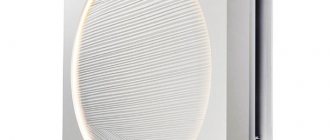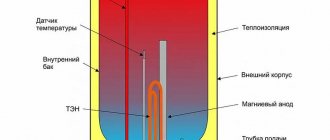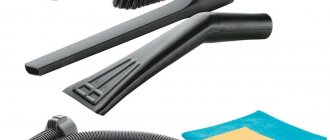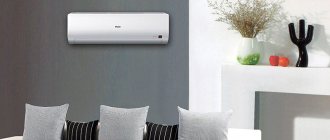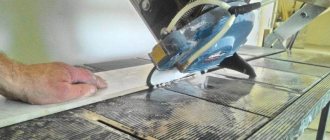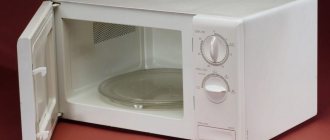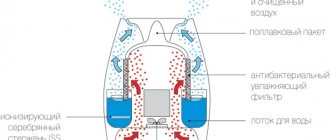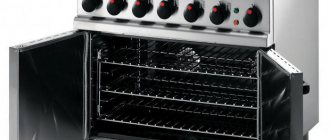Operating principle of the air conditioner
The operating principle of household air conditioners is based on heating the refrigerant. During the evaporation process, it absorbs heat from the surface - condensation occurs, due to which the air temperature decreases.
Specifications
The equipment receives power from the mains. The range of its energy consumption values is 1-2.5 kW/h. Power is the parameter that determines the area over which the unit will operate.
Purpose of the device
Household air conditioners are needed to cool the air in the apartment. The most popular places for installing these devices are the bedroom and kitchen.
Some specimens can not only cool the air, but also warm it up. This option is usually used before the start of the heating season, when the houses are already cold and heating has not yet been provided.
Important! According to the recommendations of companies involved in the production of air conditioners, you should not set the heating mode on the split system if it is more than 5°C outside.
Why it doesn’t turn on - troubleshooting
Even a household air conditioner is a fairly complex piece of equipment, so there are many reasons for it not performing its functions properly. Below are several main factors that can lead to the split system not turning on.
- If the air conditioner does not respond to commands from the remote control, you need to check the batteries - they may be dead. Then replacing the batteries will help.
- Lack of electricity in the outlet, low voltage in the network or damage to the network cable leads to the fact that the air conditioner does not turn on or turns off randomly.
- If the temperature outside the window is negative, and the external unit is not all-season, protection is triggered, which saves the system from breakdown.
- Poor cooling or heating occurs due to a refrigerant leak or high compressor wear.
Important! Before using the air conditioner, the user must read the operating instructions.
So, modern air conditioners have a wide range of basic and additional functions that allow you to create an optimal microclimate in a residential, office or industrial space. Control occurs remotely using a remote control or manually using a thermostat. Buttons have been added to the controls, providing access to all the capabilities of the technology. If the equipment does not respond to commands, you should seek professional help.
What types of air conditioners are there?
Each model has its own operating features. They are taken into account so that during operation there is no dissatisfaction with the device. The market offers new developments, but without knowing what works and how it works, it will not be possible to choose suitable climate control equipment.
Inverter climate systems
The inverter type of air conditioner allows you to maintain the same temperature, but the device does not turn off completely, but goes into reduced power mode:
- the rotation speed of the fan blades decreases;
- the performance of the compressor and heat exchanger decreases.
The advantage of this type:
- energy savings of up to 30%;
- service life increases by 50%;
- less noise;
- the device parts do not wear out.
When starting a conventional air conditioner, a large load falls on the network and the compressor. Inversion allows the mechanism to operate continuously, independently simulating the indoor climate.
With the possibility of heating
Such split systems are more expensive, but at outside temperatures from 0 to +10, they can heat the apartment. There are many advantages of such equipment:
- dries the air, preventing mold from forming on the walls;
- saves energy thanks to automatic temperature settings;
- releases 3-4 times more heat than it expends.
The disadvantage of a “warm” air conditioner is its high cost. During the cold season at sub-zero temperatures, equipment cannot be turned on without a winter kit - this leads to equipment breakdown.
Availability of winter kit
Benefits of a winter air conditioning kit
There are many myths about heating a room with air conditioning. Here are the main ones:
- With a winter set, you can fully heat your apartment: no air conditioner will heat the air even to 19 - 20 degrees if it’s minus 20 outside.
- At any temperature, split systems work as always: the efficiency in winter at low temperatures decreases by 3-4 times, so you cannot expect full-fledged heating work.
- A winter kit is needed for heating in winter: the device protects the air conditioner, which turns on in winter to cool rooms that are always hot and require heat removal.
- With a built-in winter device, the split system can always be turned on: it serves to protect against night frosts in the off-season.
For heating it is better to use convectors or other systems. They are much cheaper than air conditioning, so it's not worth the risk.
Air conditioner functionality
Depending on the model and price category, air conditioners have a certain number of functions, which can be divided into basic ones (switching on for cold and warm) and additional ones. Basic options are an integral part of the equipment, while additional ones can be included to increase comfort .
Main functionality
The original purpose of climate control equipment was to lower the air temperature in a specific room. Therefore, cooling is the first and most important option of an air conditioner. Thanks to the circulation of refrigerant inside the system, the device removes excess temperature to the outside, allowing you to create a comfortable microclimate in the living room during the hot season.
Over time, technologies have been developed that allow air conditioners to increase the indoor temperature. Therefore, heating is the second main functionality of a split system, the opposite of cooling. In the modern market, it has already become mandatory even for the budget segment, although there are still models without it (for example, Electrolux or Midea). It is these options that cannot be turned on during the cold season to avoid breakdowns.
Additional functionality
As additional features, manufacturers often equip their products with options that increase user comfort. Among them, this functionality is especially popular.
- Air cleaning. The option is provided by mechanical and carbon filters, which are installed in the indoor unit and remove physical contaminants and unpleasant odors from the air. In this mode, the air conditioner can operate without the main functionality, simply supplying fresh, purified air inside the room.
- Ionization. This option allows you to clean the supplied air from pathogens and remove even strong odors such as tobacco smoke. To do this, an ionizer must be installed inside the system.
- Functional timer. Fine-tuning the temporary operating modes of the air conditioner is an absolute plus for modern climate control equipment. Switching on according to a schedule will allow you to cool the apartment in the summer shortly before arriving from a walk or work.
- Night mode. Although modern models are already almost silent, their work can still be heard at night. For a comfortable sleep, there is a mode that switches the air conditioner to ultra-quiet operation, while continuing to actively cool or heat the room. General Climate, LG, Mitsubishi models are distinguished by silent operation
Advantages and disadvantages of air conditioners
If you are looking to buy an air conditioner or split system, you will want to know the pros and cons.
Advantages
- Ensuring a comfortable temperature in the room. Regardless of the weather outside, the split system will create a favorable atmosphere in the room. In the summer, the air conditioner will cool the air, and in the fall or spring it will heat it up. In any case, it will be comfortable to be in the room.
- Clean indoor air. This is especially true for residents of large cities living in industrial areas. Using an air conditioner will allow you to get cool, clean air without opening the windows.
- Maintaining optimal air humidity. Some models have a dehumidification function, creating an optimal level of humidity in the room.
Flaws
Please note that the air conditioner can cause harm to humans only if used incorrectly. If you do not clean the unit regularly, harmful bacteria and viruses can begin to multiply in it. Due to the way the air conditioner operates, the air in the room becomes drier, so we recommend using separate devices that increase the humidity level in the room. Compressors make a little noise during operation. Usually the compressor is located in the outdoor unit, and you can’t hear it working indoors.
Main nuances when installing a split system
The long service life, as well as the efficient operation of the system, directly depend on how correctly the equipment is installed. You can install the system yourself. The most important thing is to take your time and carefully understand the diagrams. When performing installation work, it is important not to damage the copper tubes that connect the blocks to each other and ensure their efficient operation. These elements are designed for refrigerant - freon.
To begin with, it doesn’t hurt to know how the system works. To cool the air, freon will flow from the outdoor unit to the indoor unit, which is located indoors. When the fan is turned on, it provides a strong flow of cooled air, which normalizes the temperature in the room or office.
To remove the condensate that forms, there is a special drainage pipe extending from the unit located indoors. It is quite possible to take her outside.
Before installing equipment, you need to select it correctly. Like air conditioners, split systems differ in power, so when choosing equipment you must take into account the following factors:
- area of the room in which the system will be installed;
- type of indoor unit - floor-ceiling, wall-mounted, cassette or multi-zone.
- absence or presence of forced ventilation in the room.
Air conditioner power
Power is the most important parameter of the device. There are three directions that are indicated by the manufacturer. These are cooling power, heating power and power consumption.
Cooling power (Cooling capacity)
Cooling power is the most important characteristic, which is expressed in kW or BTU. If everything is clear with power in kW, then BTU is a British thermal unit. It was in them that the power of the air conditioner was previously measured. The power of the device determines the area that it can cool in normal operating mode. Normal mode means operation of the device, without constant high loads on the compressor, which arise as a result of incorrectly calculated power of the device and the size of the room. Thus, if you put a split system designed to cool a room of 20 square meters into a room measuring 30 square meters, then due to lack of power the device will always work at increased loads in order to ensure the set temperature, which leads to rapid wear of spare parts, and as a result, early failure of the device.
When independently calculating the power of an air conditioner for a room, you should expect that 1 kW (3412 BTU/h) of the cooling capacity of the air conditioner can provide 10 sq. m. room area with a standard ceiling height (2.5-3 m). Thus6 for a room measuring 25 sq.m. the required power is 2.5 kW (approximately 9000 BTU).
Also, to independently calculate the capacity of the air conditioner, you can use this table:
Air conditioner power calculation
Heating power (Heating capacity)
Heating power is a similar characteristic of cooling capacity. It is measured and calculated in a completely similar way, but only for those devices that have this function. Today this is the majority of household split systems, but there are also models that do not support the heating function.
Power consumption
This parameter is often confused with cooling capacity or heating capacity, since it is also measured in kW. But this is a little different. The power consumption of an air conditioner is a characteristic that expresses the amount of electricity consumed by the device. It can also be different (minimum, maximum, nominal) - and, as a rule, the cooling power is several times lower. Thus, with a cooling power of 2.5 kW, the air conditioner consumes approximately 0.8 kW - less than an iron, electric kettle and many other household electrical appliances.
Energy efficiency
Air conditioner energy efficiency is a parameter that contains two previous parameters. Essentially, this is the coefficient between them. This indicator is a technical characteristic of all modern electrical appliances and reflects energy efficiency (efficiency).
If we talk about energy efficiency within an air conditioner, it is expressed as the ratio of the power produced (cooling or heating) to the electrical power consumed. If we look at an example, we will take a device with a cooling capacity of 2.2 kW and a power consumption of 0.6 kW. The energy efficiency factor will be 3.67.
Air conditioner energy efficiency
In modern electrical appliances, it is customary to divide energy efficiency into groups, from A to G, the higher the class, the more economical in energy consumption the device is considered. In our example, it is 3.67 - which belongs to class “A” (the most economical devices). Accordingly, devices of class B have more energy-consuming indicators than A, class C is more energy-consuming than B, etc.
Operating rules
As follows from the above, an air conditioner is a complex and diverse equipment for domestic and industrial use, which requires compliance with operating rules and careful care of the technical components, which will extend the proper functioning of the equipment for a long time. Despite the diversity of species, when operating different types of systems it is necessary to follow simple rules.
- To maintain a constant flow of clean air from the indoor unit, it is necessary to clean the replacement filters monthly. For this process, it is preferable to use only clean running water, without chemicals.
- In case of any disturbance in the normal operation of the air conditioner (deterioration in air flow after cleaning the filters, the appearance of an ice coat, random switching on and off, etc.), you must contact the service department for warranty or technical service.
- It is advisable to call a service department before the start of each warm season to deep clean both units from dust using a compressor, as well as diagnose the pressure and electronic parts.
- It is prohibited to turn on an air conditioner that is not equipped with an all-season unit when the temperature outside is below freezing!
On a note! More details on how to properly use air conditioning systems are described in the instructions from the manufacturer.
Sound pressure value
It is also one of the most important parameters, which essentially displays the noise level of the device and is expressed in dB. The manufacturer usually indicates the noise level of the outdoor unit, since the indoor unit often has several speeds, depending on which the noise level changes. In addition, the indoor unit is always quieter than the outdoor unit. It is worth noting that the noise level of the outdoor unit also depends on its type and size. Let’s say the “seven” block, of the “on/off” type, has a noise level of approximately 45-55 dB. But another type of air conditioner, inverter, does not have a constant noise level, but a maximum one. Since this type of air conditioner is designed in such a way that its performance constantly changes during operation, its noise level is dynamic. Therefore, it is customary to indicate only the maximum value.
Permissible operating temperature
The permissible outdoor operating temperature is a recommendation that indicates at what temperature the device can be safely used. Operating the air conditioner at a temperature that is higher or lower than the permissible temperature can lead to rapid failure of the device.
For most household split systems that are not equipped with a heating function, the lower threshold for outside temperature is 5°C. It is unlikely that you will want coolness when the temperature outside is this high, but this is an important parameter. The fact is that at this temperature, physical processes begin to change the structure of freon and compressor oil, which is why, immediately after start-up, your compressor may jam. In addition, the drain hole of the drainage hose freezes over - and all the condensation from the air conditioner will flow back into the room.
The first stage of device installation
Before starting installation work, you need to decide where to install the split system. To determine the most optimal location, it is worth considering some factors.
- Under no circumstances should the indoor unit of the system be installed where air circulation is limited. This is possible due to closely spaced cabinets, curtains or partitions.
- The distance between the equipment and the nearest obstacle should not be less than 1 meter, since cold air, reflected from it, will quickly return without changing its temperature. Because of this, the system will quickly turn off, considering that the desired temperature has been reached.
- It is advisable to locate the internal unit of the system away from the place where people spend most of their time.
It is not difficult to install a split system yourself, the main thing is to observe the correct operation during installation. So, when fastening the outdoor unit, you need to carefully ensure that:
- it was located on a flat surface, and there were no sources of heat or steam nearby;
- the block was installed strictly horizontally, so when fastening it to the surface it is advisable to use a building level;
- a unit located outside cannot be mounted close to the wall. The distance between the device and the wall should not be less than 10 cm. Air should circulate freely in the space left.
When installing the indoor unit, the following rules should be followed:
- When installing the unit, be careful. so that it is located strictly horizontally, without slopes;
- try to maintain the distance between the outdoor and indoor units;
- Do not install the equipment close to the ceiling or near sources of steam or heat.
So, when the location has been chosen, you can proceed directly to the installation work. You should start with the electrical wiring. The split system should be connected to the electrical network via a separate line specially designated for this equipment, with the obligatory installation of an additional circuit breaker in the electrical panel.
It should be borne in mind that if a house or apartment was built a long time ago and the wiring has not been changed, it may require a complete replacement, since the split system is powerful equipment, and the old wiring may not withstand the power and this will lead to permanent traffic jams. fly out."
Selecting a location
The presence of two or more units of climate control equipment requires a choice of location for each of them. Before starting installation work, you will need accompanying documentation.
Do I need permission to install an air conditioner?
Structurally, the air conditioner is a system with an indoor and outdoor unit, which is mounted on the facade.
Multi-storey building, on the basis of Art. 246 of the Civil Code is common property with the right of disposal by all owners. Installation of equipment without approval is a violation:
- the device makes noise, buzzes, disturbing the peace of the neighbors;
- condensation can damage the façade of the building or get onto the balcony below;
- the overall block blocks the view or view and windows;
- There are risks of wall cracking, wiring shorting and fire.
Based on paragraph 1 of Art. 25 LCD installation of a split system is considered as a reconstruction or re-equipment of the premises. Clause 3.5.8 of Resolution No. 170 states that it is prohibited to install an air conditioner without permission from the management company and neighbors. Consent or refusal can only be obtained after a meeting of the residents of the house.
Important! Residents of private homes can begin installation immediately after purchasing the device.
Permission is required if:
- installation work is carried out on the front part of the high-rise building;
- the user lives in a house that is valuable from a historical and cultural point of view;
- the split system is located above the pedestrian paths;
- There are no special fences on the window opening where the block is located.
Important! The management company does not have the right to remove air conditioners. Art. 330 of the Criminal Code considers such actions as arbitrariness. Dismantling of devices is carried out only by court order.
Choosing a location for the indoor unit
Installation of the internal air conditioner module is carried out with your own hands so that cold air flows do not cause discomfort. It can be placed above the head of the sofa, on the side and behind the workplace. Construction regulations define the order of location of the indoor unit:
- from the structure to the ceiling - at least 15 cm;
- from the module to the right or left wall - at least 30 cm;
- from the block to the floor - 280 cm, but for apartments on the ground floor, the external block is mounted at the same level or lower than the internal one;
- from obstacles to the movement of air flows - no less than 150 cm;
Advice! In a room with a sofa and TV, it is better to place the air conditioner above the sofa.
Where to locate the outdoor unit?
The outdoor module is placed near a window opening or on an open loggia. If the balcony is glazed, the block is placed on a fence with good load-bearing capacity or on the facade. Residents of the 1-2 floors need to determine a place for the outdoor module as far as possible from passers-by. On the 3rd or more floors, it is allowed to place the device under a window or on the side.
In a private house, the outdoor unit is placed on a wall with high load-bearing capacity. On ventilated facades, a special fastening is organized or the block is placed on the plinth.
Determining the distance between blocks
The maximum length of the intermodule route is 6 m; if it is exceeded, additional freon injection will be required. If the external and internal modules are placed at a distance of 1 m, the route should not exceed 5 m. The excess of the system is formed into a ring and placed behind the block.
Interesting to know! Manufacturers indicate different maximum distances between blocks. For Daikin equipment it is 1.5-2.5 m, for Panasonic - 3 m.
Installation procedure and features of the work
Do-it-yourself installation of a split system consists of installing blocks and laying all the necessary communications. It is important to follow the instructions from the equipment manufacturer, because each model has its own characteristics that affect the method and location of installation.
Installation of indoor and outdoor units
Installation of the indoor unit begins with choosing a location. You should make sure that there are no electrical communications or water pipes passing through the mounting points.
First of all, a plate is attached, onto which the block itself is then placed. A prerequisite must be met: the horizontal level of the split system plate must be ideal.
After working with the level, you should put marks for the holes. It is important to secure well the lower part of the plate, where the latches for the housing of the internal unit of the split system are located.
After successful installation of the plate, the indoor block is put on top and fits into the grooves, which allows it to be firmly held on the wall.
The hole for communications should be at such a height that the drainage tube slopes towards the outdoor unit (slope - 1 cm per 1 m). The diameter of the hole must be at least 5 cm. It is better to make two holes - for wires with copper pipes and separately for the drainage tube.
To mark the mounting of the outdoor unit, remember that again you need to observe the level and the fact that the drainage tube must go at an angle. Accordingly, the level of the outdoor unit is lower than the level of the indoor unit of the split system.
First, the brackets are installed. Each hole in them must be used for its intended purpose. The more anchors that hold the base, the greater the chance that the block will not fall. The unit itself is installed on the brackets using bolts.
Laying communications
The first step is to lay copper pipes. Having decided on the length, they are cut with a special tool, which was indicated above. The edges must be carefully processed with a file.
Insulating pipes are placed on top of the pipes, which serve to maintain temperature. There should be no insulation joints. Everything is tightly sealed on top with reinforced tape. Important! When pulling pipes through the hole, it is necessary to seal the access inside to prevent dirt and construction debris from entering.
The cable is quite easy to route. Stripped wires of the required size are pulled through the hole and connect the split system units.
To find where to connect the wires, you need to open the cover, which is located above the copper pipe mounts on the blocks. It is recommended to study the wire mounts before installing the system to ensure that no problems arise during the process.
Basic rules for installing and connecting an air conditioner
Installation and connection of a household air conditioner when doing it yourself requires compliance with a number of requirements.
Rules for installing the outdoor unit
The module is configured as follows:
- Testing a balcony or facade for strength is 2 times more equipment, which weighs from 10-15 to 40 kg.
- Inspection of brackets on external insulation - they must be hidden in the wall material.
- Laying a damping seal on a ventilated facade or aerated concrete walls.
- Taking into account equipment noise - the maximum permissible level is from 25 to 30 dB.
- Check for distortions at each stage of installation to prevent refrigerant leakage.
- Installation in a windy area with a canopy for protection from bad weather.
- Maintain a line distance of 15-20 cm if the equipment is located on the roof.
- Connecting the condensate collection pipe to the sewer.
Important! The distance from the outdoor unit to the wall surface is at least 10 cm.
Rules for installing the indoor unit
A second module is installed in the room and a line is laid:
- Connection to the electrical network with the organization of an individual line - the energy consumption of the air conditioner is 2 kW.
- Laying the main line externally (hidden in a box) or internally (hidden in a wall) methods.
- Maintain a distance between blocks of a maximum of 6 m for efficient operation of the structure.
- Removing household appliances, curtains from the device by 3 m.
- The air conditioner is not located above radiators or furniture.
- Maintain a distance of 20-25 cm from the block to the ceiling.
Important! The indoor unit is mounted on the wall or ceiling.
Basic installation requirements
When installing any air conditioner (including split systems), it is necessary to remove a separate power line from the panel with its own emergency circuit breaker. The socket should be located at such a distance from the indoor unit that the wire can reach there without an extension cord. Shared outlets for outdoor equipment are prohibited by law. In addition, this connection method deprives you of the right to warranty service.
The condenser blower impeller is most often located on the left when looking at the unit from outside the building. There, on the side, one of the air intake grilles is located (the second, main one, is located at the back). The distance from these grilles to any obstacles must be at least 30 cm. On the other side of the impeller (usually on the right) there is a panel where the route is connected (the so-called inter-unit part of the freon circuit) and the signal cable. There should be at least half a meter of free space on this side - this part of the device requires free access during installation, repair and maintenance of the system. There must be at least 2 meters of space in front of the impeller so that the heated air does not stand near the radiator.
The indoor unit is located at least 15 - 20 centimeters from the ceiling and walls. The minimum height from the floor is 2.5 meters, and there must be at least 3 meters of free space in front of the air outlet grille. The air from the evaporator comes out forward and down.
What to look for when buying an air conditioner
When choosing an air conditioner model, check the power rating - it should allow you to fully cool the room. In addition, you should consider:
- Type of compressor (the efficiency and reliability of an inverter air conditioner is higher than that of a non-inverter air conditioner)
- Noise level (the ideal level is considered to be 25-30 dB).
- The presence of filters (they serve to clean the air from dirt and unpleasant odors).
- Ventilation (not every device is equipped with the option of supplying fresh air; most other models do not use the outdoor unit in this mode).
- Automatic mode (this option allows the device to operate without constantly setting parameters).
- Design solution (the indoor unit is located in plain sight, as a result of which its design must match the style of the room).
Remote control - meaning of buttons
Using the remote control, you can select the main operating mode of the air conditioners, as well as activate and configure additional functionality. One of the most important buttons is the one that activates the movement of vertical blinds, due to which cold or hot air is evenly distributed throughout the entire room. The blinds can be locked in a certain position by pressing the button again.
Dehumidification and air purification is activated by the “Dry” button, marked with a droplet. In this mode, the cooling or heating rate may decrease, but the air will be much cleaner.
The timer is turned on by the button of the same name, and the activation time is adjusted using the arrows.
Regular air circulation throughout the room is also necessary; it is activated by the “Fan” button, but the temperature does not change.
How is installation done? What do you need to know about the installer?
Having purchased a split system, you need to contact a specialist to install it. The specialist will lay out a route for connecting communications. A hole with a diameter of 30-50 mm is made in the wall. An outdoor unit is installed on the street side. An internal housing is installed in the room. Next, they are connected and the entire system is purged with freon.
In order for the unit to work efficiently and for a long time, it must be installed by a person with appropriate experience and knowledge. It is best to contact a company that supplies air conditioners. Most often, their specialization includes installation.
It is not recommended to look for a master through advertisements in the newspaper. Although the installation in this case will be cheaper, if a malfunction occurs, you will have no one to file a claim with.
Installation materials and tools
To install a split system yourself you will need:
- 4-core cable with a diameter of 2 – 2.5 mm² (the exact parameter is indicated in the equipment passport);
- L-shaped brackets for installing the outdoor unit. Their load-bearing capacity should be 4 to 5 times the weight of the outer housing of the air conditioner. Before properly installing an air conditioner in an apartment, calculate the safety margin. This is necessary for reliable fastening in difficult weather conditions - snow, gusts of wind, icing. The dimensions of the brackets must correspond to the dimensions of the outdoor unit.
- Seamless copper tubes with thick walls (if they are not included in the factory configuration). Diameter in 2 options – larger and smaller. To install the air conditioner, choose special soft copper that can be easily flared. This material is used in the refrigeration industry. The length of the pipes corresponds to the length of the route + 30 cm. To prevent dust from getting inside the pipes, they are transported with capped edges.
- Rubber insulation for copper pipes. The length of the segments is equal to the length of the route. For each diameter of copper pipes, select a separate insulation material.
- Corrugated hose with an internal plastic spiral. This consumable is used as a drainage pipe. Sometimes a propylene pipe is installed instead. The length of the drainage tube is 80 cm longer than the length of the route.
- Plastic box for communications.
- Dowels, bolts, anchors. The quantity and dimensions depend on the type of walls and brackets.
In addition, to install the air conditioner yourself, stock up on a hammer drill, pipe cutters, flaring tools, and a drill.
Note! For the outdoor unit of the split system, buy a visor. It will protect the case from snow, rain, dust and other debris. Installing a canopy will extend the life of the air conditioner.
For residents of the first and second floors, it is recommended to install an anti-vandal casing.
If the tank is installed above the drain pipe, a pump will not be required, since the condensate will drain naturally. In another situation, you will have to buy a drainage pump that will pump the resulting liquid.
Review of the best models in terms of price-quality ratio
Here we present to your attention the TOP 5 relatively inexpensive home air conditioners with an optimal set of functions.
Electrolux EACS-07HG2/N3
Classic wall-mounted air conditioner from Electrolux in a stylish white casing. The split system is considered one of the best in its price segment. Quickly creates a comfortable indoor microclimate, dehumidifies and purifies the air.
The system is equipped with some of the most powerful air filters available. This is also a small disadvantage of the air conditioner - the filters quickly become dirty, but they are easy to clean.
Specifications:
- Type: wall split system;
- Modes: heating, cooling;
- Air flow – 7.83 cubic meters/min
- Power consumption: 664-685 W.
pros
- anti-corrosion coating of the external unit;
- ease of use;
- powerful air purification;
- high energy efficiency.
Minuses
- Filters clog quickly.
LG B09TS
The inverter wall-mounted split system combines a classic design solution and high performance characteristics.
The brand's patented technologies allow you to create a powerful flow of ions to purify the air, and additional filters trap small mechanical dust particles.
The air conditioner also has a self-diagnosis system via a built-in Wi-Fi module.
Specifications:
- Type: wall split system;
- Modes: heating, cooling;
- Air flow – 8 cubic meters/min
- Power consumption: 729-771 W.
pros
- efficiency;
- no vibration;
- low noise level;
- multi-stage air purification;
- unique design.
Minuses
- high price.
Roda RS-A09F/RU-A09F
Compact wall-mounted split system with good functionality. Despite its budget, the model is manufactured to the highest quality standards, taking into account all modern safety requirements.
A high-quality compressor provides rapid cooling of the room and maintains a comfortable temperature. Users note that control is not very convenient due to dual key assignments.
Specifications:
- Type: wall split system;
- Modes: heating, cooling;
- Air flow – 8 cubic meters/min
- Power consumption: 825 W.
pros
- anti-mold coating of evaporators;
- low price;
- low energy consumption;
- small dimensions.
Minuses
- noisy indoor unit;
- inconvenient controls;
- Dust sticks to the body.
Electrolux EACS/I-09HM/N3_15Y
An inverter wall-mounted split system, suitable for small spaces due to its small dimensions.
The power of the air conditioner is enough to maintain a comfortable temperature in a room up to 25 sq.m. Ideal for small apartments and studios, compact offices.
There are two filters included - anti-allergenic and bactericidal.
Specifications:
- Type: wall split system;
- Modes: heating, cooling;
- Air flow – 8 cubic meters/min
- Power consumption: 775-777 W.
pros
- silent operation;
- compactness;
- remote control;
- multifunctionality.
Minuses
- slightly overpriced due to additional features.
Electrolux EACS-09HG2/N3
The 2021 model remains popular in the market due to its original design and functionality.
Multi-stage air purification is provided by a cold plasma generator, which decomposes unpleasant odors and aerosols, and also kills pathogenic air microflora.
The controls are intuitive and clear; during operation, the system has a low noise level and no vibration.
Specifications:
- Type: wall split system;
- Modes: heating, cooling;
- Air flow – 8.83 cubic meters/min
- Power consumption: 733-824 W.
pros
- high energy efficiency;
- low noise level;
- multi-stage air purification;
- functionality.
Minuses
- There is no plug included.
The best split system air conditioners for apartments
Split-type air conditioners for apartments are characterized by higher power and lower noise when compared with mobile and monoblock window devices. Another undoubted advantage is the variety of types of internal units of split systems: wall-mounted, floor-ceiling and cassette. Our rating presents the best split system air conditioners based on reviews.
LG P07SP
The inverter wall-mounted split system with a cooling power of 2.05 kW is designed for an area of up to 20 m². The VCS monitors energy consumption and performs smart diagnostics. The comfortable atmosphere is not disturbed by loud operation, the minimum noise level is 19 dB, the maximum is 33 dB. LG P07SP is equipped with an antibacterial filter that purifies the air from harmful germs and allergens.
Pros:
- Rapid cooling and heating of the room
- Almost no noise
- The internal unit of the device is easy to clean
Minuses:
- Remote control without backlight
- No network cables included
Panasonic CS-E7RKDW/CU-E7RKD
The inverter model is similar in power and functionality to the previous split system, but it has its own characteristics. Panasonic CS-E7RKDW/CU-E7RKD uses iAutoX technology, which achieves high speed operation of the compressor and the internal fan unit. As a result, the specified parameters are achieved 35% faster than in earlier analogues.
The random automatic restart function allows the device to operate without a starter. After a power failure or emergency power outage, the air conditioner resumes operation. In this case, the SCR units are turned on not simultaneously, but in order of priority. 32 standard circuits guarantee protection against power surges and increase the service life of the device.
Pros:
- The long pipeline of the system makes it possible to move the indoor and outdoor modules as far as possible from each other
- A standard 15 meter long pipeline can be extended to 20 and 30 meters
- Saving energy without losing comfort
- Air exchange is designed in such a way that it eliminates microorganisms and mold spores
- The interior panel is easy to remove and wash
- There is a function for recognizing high activity of people indoors
Minuses:
- The air flow cannot be directed parallel to the ceiling
Hisense AS-07UR4SYDDB1G
A compact wall-mounted split system can easily fit not only above the bed in the bedroom, but also on the wall near the window in the children’s room or kitchen. For a model in the mid-price category, Hisense AS-07UR4SYDDB1G has quite a wide range of functionality. The air conditioner operates in ventilation mode, automatically maintains the temperature and regulates the air flow, diagnoses faults itself, and prevents the formation of ice. The device is equipped with an anion generator, a deodorizing filter, and a settings memory function.
Pros:
- Small size and functionality of the split system
- Virtually silent operation
- Automatic support of the set temperature
- Inverter compressor helps save energy
Minuses:
- Curtains move noisily
Shivaki SSH-L079DC
The Lux Inverter series model operates in “heat-cold” mode, providing comfort over an area of 9 to 16 m². Additional options: sleep, heating, ventilation, dehumidification. A high energy efficiency class allows you to save energy. The minimum noise level of the indoor unit is only 18 dB. The split system is equipped with a plasma generator that protects the air flow from the smallest particles of dust and smoke through an electrostatic filter. Shivaki SSH-L079DC filtration includes purification with a natural antiseptic catechin, as well as treatment with activated carbon, which can absorb most harmful substances, and enrichment of the air with vitamin C.
Pros:
- Ultra-modern air conditioner design
- Very quiet indoor unit
- Smart airflow distribution thanks to Smart Airflow
- The position of horizontal and vertical blinds is controlled by remote control
- The device automatically remembers the position of the curtains
Minuses:
- Short wire for connecting to an outlet
- Wi-Fi module must be purchased separately
Samsung AR09RSFHMW
The best split system according to user reviews. This wall-mounted model is suitable for use in a room up to 25 m². The air conditioner is equipped with fine filters, a deodorization system and an ice prevention system. The inverter compressor is responsible for the quiet operation of the Samsung AR09RSFHMW. Users note only a slight noise of the air flow passing through the fans, as well as the reliability of the SCR. The large heat exchanger and air intake have a positive effect on operating efficiency. The grille of the indoor unit can be removed in a few seconds, which makes cleaning the device much easier.
Pros:
- High-quality assembly and metal external unit
- Instant cooling of a room of the stated dimensions
- Heating works properly, starting from –5 °C outside
- Interesting, original design
- Fairly reasonable price
Minuses:
- At the initial stage of use, an unpleasant plastic odor may appear
- Complete absence of wires included
- The manufacturer did not cover up the bright LEDs on the display
Split system installation
Installation of a split system in an apartment is carried out in the following order:
- We determine the location(s) of the internal units(block).
- We lay the electrical wiring.
- Installing the outdoor unit.
- We punch a hole in the wall for communications.
- We prepare and lay pipelines.
- We install the electrical connections of the blocks.
- We check the tightness of the system.
- We evacuate the system.
- We fill the system.
- Connect the power supply.
- We test the split system as a whole.
- Additionally, we insulate the interblock harness.
- We close the hole in the main wall.
- We take advantage of the newfound amenities and/or begin renovations.
Now let’s describe some features of each stage of work. The permissible distances from the walls and ceiling for indoor and outdoor units are shown in the figure on the right.
Spaces for indoor units
Indoor units cannot be installed:
- Above radiators and other heat sources.
- Behind curtains, curtains, screens and other obstructions to air flow.
- In rooms with sources of electrical interference: workshops with power tools, induction and microwave ovens, electric ovens, interference can damage the unit’s processor.
The question immediately arises: what about the kitchen? It turns out that you can’t install air conditioning in it at all. Right. The flow of conditioned air into the kitchen is ensured by indoor ventilation.
Wiring
The lowest-power air conditioner consumes 1.5 kW of electricity. Therefore, you need to lay separate wiring for it with a cross-section of at least 1.5 square meters. mm and install an automatic switch - like for a boiler or washing machine.
When connecting wires to the input panel, connect the yellow wire with a longitudinal green stripe to the neutral (neutral wire). Phase and zero are determined by the phase indicator. If the wiring is made from wires insulated in non-standard colors, zero and phase must be marked at both ends.
Outdoor unit
Installation of the outdoor unit has already been described above.
Hole in the wall
Firstly, if the house is block-built, you need to determine in advance the location of the reinforcement. It is impossible to cut off the reinforcement that is in the hole: the external wall is always load-bearing, and damage to the reinforcement is unacceptable.
Secondly, a second person is needed: he must stand below and warn passers-by. An accidentally dropped piece of concrete or brick can cost the owner a long prison sentence.
The diameter of the hole must be at least 80 mm. Recommendations of 60 and even 50 mm clearly do not take into account thermal insulation.
Pipelines
We cut the tubes to size with a margin of 1 m for bends. The tubes must be bent carefully to avoid kinks or wrinkles. Wrinkles create resistance to the flow of the agent, and this entails increased electricity consumption. The permissible bending radius of the tubes is at least 100 mm.
Next, we put thermal insulation made of flex on the tubes - polyurethane foam hoses. Use foam rubber, etc. You can’t use improvised materials - they won’t even last a season.
Then we put threaded flanges (“nuts”) on the tubes and flare the ends of the tubes. Make sure that the flanges are put on correctly - with the thread towards the end of the tube.
Finally, we connect the pipelines to the fittings. This must be done one at a time so that the cold fitting of the indoor unit is not connected to the hot fitting of the outdoor unit. The matter is made easier by the fact that in most air conditioners the hot and cold fittings are of different diameters.
We tighten the flanges on the fittings tightly, but not too tightly: the copper can be easily pinched. We will tighten the threaded connections later, when sealing.
For drainage you need a piece of reinforced plastic tube. We connect it to the drain pipe either with a threaded flange, if provided, or using a piece of heat-shrinkable tubing. You can heat the heat shrink with a soldering iron using light circular movements, slightly touching the tube with the tip.
Electrical connections
Multi-core wires in insulation with a cross-section of at least 1.5 square meters. mm we connect the same terminals of the indoor and outdoor units. If the names of some terminals do not match, we figure it out according to the instructions and consult a specialist. Of course, we run both pipelines and wires through the hole in the wall.
Sealing
When sealing, we use a method proven by generations of gas workers: a soap solution. We buy 0.5 liters of distilled water at the pharmacy, heat it “to steam” and, stirring carefully, dissolve a spoonful of laundry soap shavings in it.
To seal, remove the outlet nipple and connect a bicycle pump to its nozzle with a rubber hose. One person pumps it up, the other applies a soap solution to the threaded connections with a brush and tightens them until bubbles stop appearing, and another 1/8 turn. Soap deposits can be removed with a damp cloth.
Vacuuming
After sealing, the system must be evacuated to remove dust and moisture along with the air. To do this, put the nipple in place, tighten it well, attach a vacuum pump to it and pump for an hour - you need all the moisture in the system to evaporate in a vacuum and be pumped out with the remaining air.
Filling and watering
We fill the system from the refrigerant cylinder through an adapter with a pressure gauge to the pressure specified in the instructions.
Attention! It is impossible to fill air conditioners designed for freon with refrigerant, and vice versa.
We connect the power supply wires in strict accordance with the designations on the terminal block - 0 to 0 or N (neutral), phase wires - by color.
Testing
We turn on the air conditioner circuit breaker. The air conditioner should then enter test mode itself. If it doesn’t work, we run the test from the remote control. If this doesn’t work out, alas, all guarantees are lost if you install it yourself. You need to call a specialist.
Completion
If the test passes, cold air flows, the blinds are installed in the desired position and swing, we first wrap the interblock harness on top with a metallized film (you can use an aluminum baking sleeve) - additional thermal shielding will give 2-3% energy savings. Then we wrap the entire harness with the drainage tube with moisture-resistant tape. All that remains is to seal the hole in the wall (thoroughly, not with foam) - and that’s it, the split system in the apartment was installed with your own hands.
The best premium air conditioners for home
In high-priced products, manufacturers place emphasis on the reliability of components and the flawless operation of the device in any climatic conditions. In air conditioners from the high price segment, external units can be protected with anti-corrosion casings. Such split systems are often equipped with inverter compressors with powerful copper windings that can withstand current loads and high-quality microprocessor control with protection against voltage surges.
A frequent requirement for devices is high cooling power and provision of comfort for large rooms. Our top list contains the characteristics of models from world-famous brands, designed for various operating conditions.
Samsung AJ068RBTDEH/AF
The inverter indoor unit of the multi-split system is sold complete with a built-in air filter and IR remote control. The model is equipped with power-saving technology when turning on and off, allowing you to reduce energy costs. Samsung AJ068RBTDEH/AF is equipped with two fine filters that remove the smallest dust particles from the air. Filtration elements must be periodically washed in running water. For this purpose, easy removal and reinstallation of parts is provided. The cooling power is 6.8 kW, the room area is 70 m², the noise level is from 29 to 49 dB.
Pros:
- In standby mode, the device does not consume electricity
- Stable and efficient operation
- Low vibration and noise levels
- There is an auto restart, night mode and continuous movement of the dampers
- Horizontal airflow is adjusted automatically
Minuses:
- No cons identified
Mitsubishi Heavy Industries SRK20ZSPR-S
The premium brand has developed an inverter series of wall-mounted split systems for harsh climates. Mitsubishi Heavy Industries SRK20ZSPR-S is one of the models in the line that provides fast cooling and heating after starting. The device accurately maintains the set temperature parameters, consuming minimal energy. The device is capable of cooling at outdoor temperatures down to –15 °C and heating down to –20 °C. The automatic operation of the unit is ensured by three sensors.
Two of them are located on the indoor unit, one on the outdoor unit. Air conditioning parameters are determined by the system after analyzing humidity readings, room and street temperatures. The air is filtered using a washable air filter. The cleanliness of the indoor module is maintained by self-cleaning, which turns on automatically after the air conditioner is turned off. Antimicrobial fan prevents mold and resists germs.
Pros:
- Inverter system of an expensive brand at an affordable price
- Quiet operation, slightly noticeable hum at maximum speed
- The heat exchanger is thoroughly dried if you turn on the special auto-cleaning mode
- Long service life if installed correctly
Minuses:
- The fan only has three speeds
- Control panel without backlight
Daikin FTXB20C / RXB20C
The air conditioner with the lowest possible noise is equipped with a filter against the hair of cats and dogs, and synanthropic ticks. Photocatalytic filtration protects the air from viruses, bacteria, allergens, and unpleasant odors. The compressor allows the air conditioner to reach the desired settings in a matter of minutes. The split system is conveniently controlled using a remote control on which the timer, operating mode, and required heating or cooling power are set. The design parts are treated with an anti-corrosion coating, the gold-plated heat exchanger resists oxidation processes well.
Pros:
- Durable matte plastic indoor unit
- High precision in temperature maintenance
- Virtually silent operation
- Smooth change in temperature parameters
- Low electricity consumption
Minuses:
- Vertical blinds must be moved manually
- Temperature cannot be adjusted in drying mode
Dantex RK-18SSI
The power control of this inverter air conditioner is done through 180° AC technology. As a result, the level of reliability and stability increases, the time of energy consumption is reduced, and the accuracy of cooling and heating is increased. The device is equipped with filters – carbon and silver ions. Built-in microprocessor controlled defrost ensures intelligent defrosting of the capacitor.
The “+8°C” mode is very useful in country houses without central heating and in dachas. Independent dehumidification is performed automatically, maintaining optimal humidity in the room. Auto-restart mode restores all previously designated settings in the event of a sudden power outage. Caring for Dantex RK-18SSI is not difficult. To do this, simply remove the panel and treat it with a regular detergent.
Pros:
- Excellent, uninterrupted operation and minimal maintenance problems
- Advanced functionality with a lot of important modes
- Intuitive IR remote control
Minuses:
- High price
